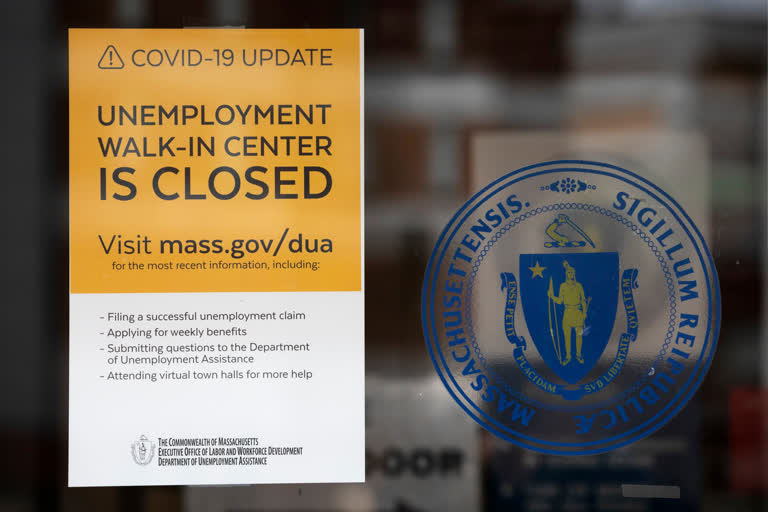Washington: Nearly 3 million laid-off workers applied for US unemployment benefits last week as the viral outbreak led more companies to slash jobs even though most states have begun to let some businesses reopen under certain restrictions.
Roughly 36 million people have now filed for jobless aid in the two months since the coronavirus first forced millions of businesses to close their doors and shrink their workforces, the Labor Department said Thursday.
Still, the number of first-time applications has now declined for six straight weeks, suggesting that a dwindling number of companies are reducing their payrolls.
By historical standards, though, the latest tally shows that the number of weekly jobless claims remains enormous, reflecting an economy that is sinking into a severe downturn. Last week's pace of new applications for aid is still four times the record high that prevailed before the coronavirus struck hard in March.
Read also:US jobless claims soar past 30 mn, Europe reeling also
Jobless workers in some states are still reporting difficulty applying for or receiving benefits. These include free-lance, gig and self-employed workers, who became newly eligible for jobless aid this year.
The states that are now easing lockdowns are doing so in varied ways. Ohio has permitted warehouses, most offices, factories, and construction companies to reopen, but restaurants and bars remain closed for indoor sit-down service.
A handful of states have gone further, including Georgia, which has opened barbershops, bowling alleys, tattoo parlors and gyms. South Carolina has reopened beach hotels, and Texas has reopened shopping malls.
Data from private firms suggest that some previously laid-off workers have started to return to small businesses in those states, though the number of applications for unemployment benefits remains high.
Read also:'Obamagate makes Watergate look small-time'
The latest jobless claims follow a devastating jobs report last week. The government said the unemployment rate soared to 14.7% in April, the highest rate since the Great Depression, and employers shed a stunning 20.5 million jobs. A decade's worth of job growth was wiped out in a single month.
Even those figures failed to capture the full scale of the damage. The government said many workers in April were counted as employed but absent from work but should have been counted as temporarily unemployed.
Millions of other laid-off workers didn't look for a new job in April, likely discouraged by their prospects in a mostly shuttered economy, and weren't included, either. If all those people had been counted as unemployed, the jobless rate would have reached nearly 24%.
Most economists have forecast that the official unemployment rate could hit 18% or higher in May before potentially declining by summer.
The job market's collapse has occurred with dizzying speed. As recently as February, the unemployment rate was 3.5%, a half-century low. Employers had added jobs for a record 9½ years. Even in March, unemployment was just 4.4%.
Now, with few Americans shopping, traveling, eating out or otherwise spending normally, economists are projecting that the gross domestic product — the broadest gauge of economic activity — is shrinking in the April-June quarter at a roughly 40% annual rate. That would be the deepest quarterly contraction on record.
Few analysts expect a quick rebound. Federal Reserve Chair Jerome Powell warned Wednesday that the virus-induced recession could turn into a prolonged downturn that would erode workers' skills and employment connections while bankrupting many small businesses.
Powell urged Congress and the White House to consider additional spending and tax measures to help small businesses and households avoid bankruptcy.
Powell spoke a day after House Speaker Nancy Pelosi, a California Democrat, proposed a $3 trillion aid package that would direct money to state and local governments, households and health-care workers. Trump administration officials have countered that they want to first see how previous federal aid packages affect the economy. And Republican leaders in Congress have expressed skepticism about approving significant more spending right now.
Trump is applauding the moves to reopen states' economies in hopes of reducing unemployment. So far, there is limited evidence on how that is working.
Homebase, a software company that provides time-clock technology to small businesses, has tracked how many employees have clocked in and for how many hours since the pandemic struck. Though Homebase's data suggests that some people have returned to work in states that have partially reopened, it's unclear how sustainable that trend can be unless many more customers return. All states remain far below their pre-virus employment levels.
In Georgia, which began reopening in late April, the number of people working at small businesses on Tuesday was down 37% compared with the beginning of March, according to Homebase's data. That is an improvement from mid-April, when the number of employees working had fallen by half.
In New York, which remains mostly shut down, employment at small businesses is down 63% as of Tuesday, only slightly better than in mid-April.
AP
